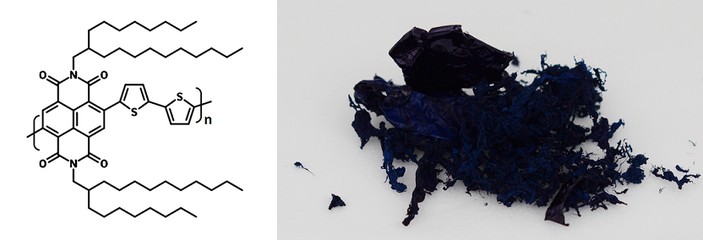PNDI(2OD)2T
CAS Number 1100243-40-0
Luminosyn™ Polymers, Materials, OFET & OLED Polymer Materials, OPV Polymers, Semiconducting PolymersP(NDI2OD-T2), electron acceptor in polymer solar cells
High mobility n-type polymer semiconductor available online for priority dispatch
Overview | Specifications | MSDS | Literature and Reviews
PNDI(2OD)2T (CAS number 1100243-40-0), a copolymer of naphthalene diimide (NDI) and bithiophene unit, has been intensively studied for use as an electron acceptor in polymer solar cells. This is due to its high electron mobility, high electron affinity, and broad light absorption. All polymer solar cells with PNDI(2OD)2T as an acceptor and J51 as a donor (fullerene-free) have demonstrated a power conversion efficiency over 8% [1].
PNDI(2OD)2T is also known as a high-mobility n-type polymer semiconductor. PNDI(2OD)2T-based OFET devices have electron mobilities up to 0.45–0.85 cm2V-1 s-1[2].
PNDI(2OD)2T from Ossila was used in the high-impact paper (IF 18.81), Tuning Contact Resistance in Top-Contact p-Type and n-Type Organic Field Effect Transistors by Self-Generated Interlayers, T. Sarka et al., Adv. Funct. Mater., 1805617 (2020); DOI: 10.1002/adfm.201805617.
Luminosyn™ PNDI(2OD)2T
Luminosyn™ PNDI(2OD)2T is now available.
High molecular weight and high purity
PNDI(2OD)2T is purified by Soxhlet extraction with methanol, hexane and chlorobenzene under an argon atmosphere
Batch-specific GPC data
Have confidence in what you are ordering; batch-specific GPC data for your thesis or publications
Large quantity orders
Plan your experiments with confidence with polymers from the same batch
General Information
| Full name | Poly{[N,N'-bis(2-octyldodecyl)naphthalene-1,4,5,8-bis(dicarboximide)-2,6-diyl]-alt-5,5'-(2,2'-bithiophene)} |
| Synonyms |
|
| Chemical formula | (C62H88N2O4S2)n |
| CAS number | 1100243-40-0 |
| HOMO / LUMO | HOMO = -5.77 eV, LUMO = -3.84 eV [1] |
| Classification / Family | PNDI polymers, Organic n-type semiconducting materials, Organic photovoltaics, Polymer solar cells, Electron-acceptor polymers, OFETs, Perovskite solar cells. |
| Soluble in | Chloroform, chlorobenzene, dichlorobenzene |
| Recommended Processing Solvents at 10mg/ml | Chloroform |
Batch Details
| Batch number | MW | Mn | PDI | Stock info |
|---|---|---|---|---|
| M1201A4 | 186,027 | 90,949 | 2.05 | In Stock |
Chemical Structure

MSDS Documentation
Literature and Reviews
- All-Polymer Solar Cells Based on Absorption-Complementary Polymer Donor and Acceptor with High Power Conversion Efficiency of 8.27%, L. Gao et al., Adv. Mater., 28, 1884–1890 (2016); DOI: 10.1002/adma.201504629.
- A high-mobility electron-transporting polymer for printed transistors, H. Yan et al., Nature, 457 (2009); doi:10.1038/nature07727.
- Highly efficient charge-carrier generation and collection in polymer/polymer blend solar cells with a power conversion efficiency of 5.7%, D. Mori et al., Energy Environ. Sci., 7, 2939-2943 (2014); DOI: 10.1039/C4EE01326C.

 PNDI(2OD)2T MSDS sheet
PNDI(2OD)2T MSDS sheet